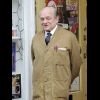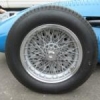This unusual wartime hobby for creating miniatures also embraced model racing cars and, again in 1942, he [Wallis] designed and constructed the first electric slot-car racing circuit. The model cars were 3 inches in length with self-steering front wheels that followed a slot in the track; an idea developed later by others and commercially produced for considerable profit.
The author refers to the motors being hand-made with 5/16th inch armatures, and the first track being constructed on a black-out board from one of the windows in Ken's Bomber Command billet. He describes the technicalities of the cars and track over the next 2-3 pages, including how Ken's developments ended-up being used in the "Scalextric" system after his civilian business partner (who was thereby able to take-out Patents in his own name, while Ken, being in the Services, could not) failed to take-out said Patents whilst supposedly marketing Ken's system.
With all due respect, this is erroneous information, and as a person currently writing an extensive history of the hobby, I must intervene.
No doubt that Ken Wallis was one of the pioneers in the hobby and is deserving of historical attention, but several persons well before him had already not only devised but patented a slot car racing system.
There were many who dabbled with the idea, incredibly enough the oldest found being a patent for such in... 1899!!!
Below are excerpts from the new book I am now completing:
The first known example of a true slot car system was patented in the United States; it was awarded to Albert E Cullen, who was born and raised in England. After effectively inventing what is believed to be the first true "slot" racing car, he applied for a patent on March 27, 1936 and this was granted in March 1938. The patent showed that the concept was already well thought out. He received an offer for his invention by the Gilbert and Marx toy companies, but the offer was apparently not something he would accept, so the invention simply died.
This patent (all pages) can actually be easily found on the Internet.
But there are others, even before Cullen, as some of you will read in that new book when it is issued (others will love the pictures!). Another inventor, Charles Woodland, had it all figured out as early as 1935 and had his running models shown in Model Maker in 1949.
In 1935, British engineer Charles Woodland, after dabbling with various raised-rail track designs, had a similar idea as that of Cullen, of replacing the rail with a slot, thus allowing the car to drift or even spin clear across the track, something difficult to achieve with a raised rail, regardless of the claims by Patrick Kennedy... It took another 14 years for him to make it practical, but by 1949, Woodland had built a successful slot car, using a slim line model-train motor and various off-the-shelf (mostly toy train) components.
Patrick Kennedy had been manufacturing a racing set in which 4 to 6 cars could race on a raised rail. This had been embraced by none other than "Tim" Birkin:
Patrick Kennedy was the brother in law of Bertie Kensington-Moir, the Bentley racing team manager. In 1932 Sir Henry "Tim" Birkin, one of the famous "Bentley Boys", along with Captain Wolf Barnato who financed and developed the famous supercharged Bentley racing automobiles, visited Kennedy at his home, driving the little cars. This was the subject of a story in The Autocar, one of the top British automotive magazines.
In fact, by the time Victory Industries Products, then Minimodels (producers of the Scalex windups) introduced their VIP and Scalextric sets in 1957, the Cullen and all other patents regarding slot cars had expired. A new patent was no longer to be anything than a design patent and not that of an "invention".
The biggest news happened in April (1957) when two British companies, Minimodels on one side and Victory Industry Products (V.I.P.) on the other, started the ball rolling on a grand scale at nearly the same time. Minimodels introduced electrically motorized versions of their Scalex friction-powered Maserati tinplate cars, two of them racing side by side on a rubber-like plastic track with sunken steel rails on each side of the slot. The set was battery powered and controlled by push buttons. The cars were painted in two different colors and were racing against each other in realistic fashion.
An earlier Minimodels design had a raised-rail track similar to that invented by Baigent, but its fragile nature was discarded in favor of a slot. Engineer Fred Francis is credited with this design evolution of the spring powered Scalex models. In this book, you will find a rebuttal of this long-accepted theory, and research shows that all that has been published and popularized may not have been the full story. This author simply exposes both claims and will let the learned reader to draw his own conclusions.
In any case, Minimodels unveiled their commercially available slot car home-racing system at the Harrogate toy fair, under the trade name "Scalextric".
V.I. P. beat Minimodels by a month or so with their first slot car racing set. Their design used a built-up tinplate track with a plastic slot. The steel roadway provided the means of getting current to the braided contacts. The set featured models of an MGA and an Austin-Healy with much more advanced features than that of the rather crude Scalextric system.
I did not of course, forget Mr. Wallis who deserves some credit, but not the one of the actual invention:
In 1942, Ken Wallis, a British serviceman (not to be mixed with Ken Wallis, designer of the 1967 STP-Paxton Indy car), experimented with small electric powered models running on a track featuring at first, a raised rail, then a slot. The tiny cars, hardly larger than HO scale, had fully hand-built motors, chassis and bodies and used watch gears for power transmission. The first type picked its power from a guiding rail and foil ribbon glued on a Masonite track, the later had an offset pin guide and power was by a copper ring around each rear wheel, definitely not the best for traction! Wallis is the engineer who created, among other interesting devices, the small autogiro helicopter "Little Nellie" used in a James Bond movie epic set in Japan.
Fact is, Mr. Wallis cars were rail-racing cars that he later modified to "slot", but not in the conventional way as the cars were racing NEXT to a slot. This change took place likely in late 1944. Some of his models have survived. In any case, Mr. Wallis would not have been able to patent his ideas as a "primary design" patent then, because there were other patents already granted for the slot car racing system.
T54
Edited by T54, 06 September 2012 - 03:04.























